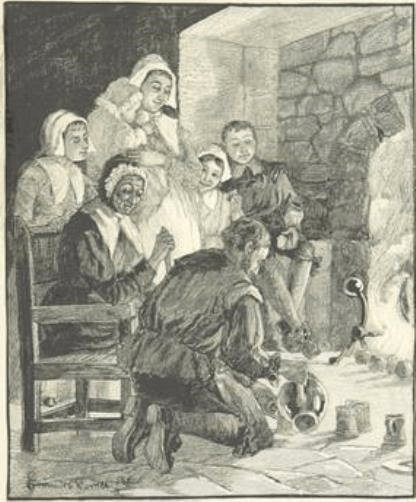Happy Nutcrack Day!
Doesn’t have the same ring to it as Happy Halloween does it? It has to be said this wasn’t a holiday particularly recognised by the Georgians, and almost certainly wouldn’t have been celebrated by a family as well-to-do as the Austens. However, the working classes, the Scots and Northern English, did celebrate 31st October, but with cake and nuts, rather than ghosts and candy. Sometimes called ‘The Oracle of the Nuts’, friends would sit around the fire eating newly harvested hazelnuts or chestnuts, and indulge in a bit of amateur fortune telling. A young man might give each nut the name of a possible sweetheart, fling them all into the fire, then watch to see which nut burned brightest in the flames, as evoked in John Gay’s poem:
The Spell:
Two hazel-nuts I threw into the flame,
And to each nut I gave a sweetheart’s name:
This with the loudest bounce me sore amazed,
That in a flame of brightest colour blazed;
As blazed the nut, so may thy passion grow,
For ’twas thy nut that did so brightly glow!
Excuse me while I daydream for a short while about Mr Darcy playing this game—throwing a hazelnut named Elizabeth into the fire—I have no doubt a small inferno would erupt; a blaze so big even Lady Catherine’s magnificent fireplaces would struggle to contain it!
Okay, back in the room now. Sorry, got lost for quite a while there, contemplating of Mr Darcy’s nuts.

Another poet, that great Scot Robert Burns, describes a similar game whereby a young couple would put two nuts into the fire. Apparently, their future happiness was dependent on whether their nuts burned quietly together, side by side, or jumped apart.
Burning the nuts is a favourite charm.
They name the lad and lass to each particular nut, as they lay them in the fire;
and accordingly as they burn quietly together, or start from beside one another,
the course and issue of the courtship will be.” (R.Burns)
I like to think that if they were thrown into the fire together, Caroline Bingley’s nut (tasteless, shrivelled and well past its sell-by date) might be repelled violently by Mr Darcy’s nut (rough on the outside, but once cracked open, smooth, sweet and moreish). There would be a great fiery crack and Miss Bingley’s nut would be flung out of the fire completely, only to land forlornly upon the hearth.
Despite the romantic opportunities they might have presented for her characters, our dear Jane doesn’t seem to have been a great lover of customs, traditions or holidays. Easter, St Valentine’s Day and the like, are rarely mentioned in her novels, sometimes as a marker in the passage of time, but often not at all. I suppose she was a clergyman’s daughter and perhaps these occasions were marked only by simple church services.
Ghosts, ghouls, and things that go bump in the night are not a feature of her work. Indeed, her naive young heroine Catherine Moreland, due to her obsessive reading of the Mysteries of Udolpho, makes a great fool of herself and nearly ruins all her future hopes when she imagines that mystery and evil lurk in every dark corner of Northanger Abbey. But while Ms Austen did not seem to hold much truck with superstition and tales of the unexpected, hasn’t it been a blast this month at Austen Variations? Vampires, dragons and pirates, oh my! I’ve really enjoyed reading all the extracts and short stories. So much so, that I find myself a little saddened that October and ‘Fanastical Austen’ is almost over.
I have a strong feeling though, that many more treats lay ahead as we move into November and we start thinking ahead to a holiday that Jane Austen does mention frequently, Christmas! In the regency period, Christmas seems to be a time of true celebration—family gatherings, visits to friends, balls and other general gaiety—complete with roaring fires, home-made decorations and lots of cold pies. I can’t wait.
Only 58 shopping days to go my friends, are you ready? I have already stocked up on nuts.


4 comments
Skip to comment form
Great post, Caitlin. This is a subject that’s always interested me. Thanks for sharing. 🙂
I really enjoyed this, Caitlin! I knew very little about these traditions and was intrigued 🙂 . Thanks for your post!
Thanks Katie, Marilyn. It’s funny but in UK we always think of Halloween as an American Holiday, but it seems it started in Scotland and Ireland, migrated over to the States and now has come back in the form of ghosts and trick or treating.
This actually sounds like a charming, harvest-y kind of tradition that is in keeping with autumn. Where I am, in Northern California, we don’t get that dramatic a change in the weather, and certainly not as many leaves changing, and I don’t certainly think about harvest-time or autumn all that much. It’s an interesting observation that Jane Austen might not have celebrated such holidays – they seem like gentle traditions that I wouldn’t have imagined would have been seen as contradictory with the church.